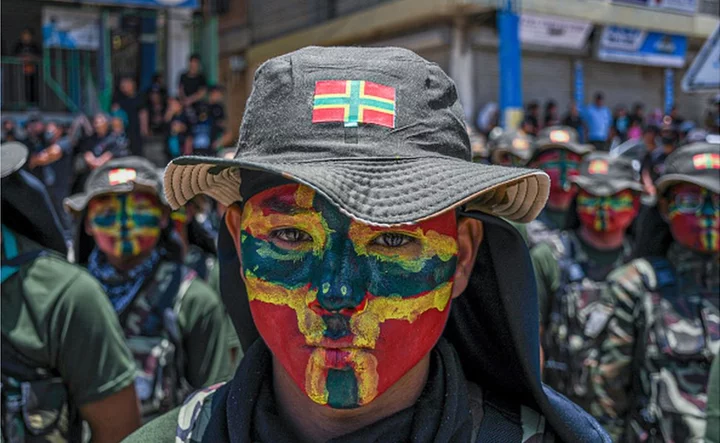By Anne Kauranen, Johan Ahlander
TORNIO, Finland/KARLSKRONA, Sweden (Reuters) -High above a railway bridge spanning a foaming river just outside the Arctic Circle, Finnish construction workers hammer away at a project that will smooth the connections from NATO's Atlantic coastline in Norway to its new border with Russia.
"We will be removing some 1,200 of these one by one," says site manager Mika Hakkarainen, holding up a rivet.
Until February 2022, the 37-million euro ($41 million) electrification of this short stretch of rail – the only rail link between Sweden and Finland – simply promised locals a chance to catch a night train down to the bright lights of Stockholm.
After Russia invaded Ukraine, that changed.
Now Finland is part of NATO, and Sweden hopes to join soon.
As the alliance reshapes its strategy in response to Russia's campaign, access to these new territories and their infrastructure opens ways for allies to watch and contain Moscow, and an unprecedented chance to treat the whole of northwest Europe as one bloc, nearly two dozen diplomats and military and security experts told Reuters.
"PUT RUSSIA AT RISK"
The Finnish rail improvements around Tornio on the Swedish border are one example. Due for completion next year, they will make it easier for allies to send reinforcements and equipment from across the Atlantic to Kemijarvi, an hour's drive from the Russian border and seven hours from Russia's nuclear bastion and military bases near Murmansk in the Kola peninsula.
Among forces based there, Russia's Northern Fleet includes 27 submarines, more than 40 warships, around 80 fighter planes and stocks of nuclear warheads and missiles, data collected by the Finnish Institute of International Affairs (FIIA) shows.
In a military conflict with NATO, the Fleet's main task would be to secure control of the Barents Sea and stop ships bringing reinforcements from North America to Europe through the waters between Greenland, Iceland and the UK.
That's something Finland can help NATO resist.
"It's all about containing those kinds of capabilities from the north," retired U.S. Major General Gordon B. Davis Jr. told Reuters.
Besides opening its territory, Helsinki is buying the right assets, particularly fighter jets, "to add value to (the) northeastern defence and, frankly, in a conflict put Russia at risk," he said.
Sweden's contribution will, by 2028, include a new generation of submarines in the Baltic Sea that Fredrik Linden, Commander of Sweden's First Submarine Flotilla, says will make a big difference in protecting vulnerable seabed infrastructure and preserving access – currently major security headaches, as the September 2022 destruction of the Nord Stream gas pipelines showed.
"With five submarines we can close the Baltic Sea," Linden told Reuters. "We will cover the parts that are interesting with our sensors and with our weapons."
Analysts say the change is not before time. Russia has been actively developing its military and hybrid capabilities in the Arctic against the West, partly under the cover of international environmental and economic cooperation, the FIIA's Deputy Director Samu Paukkunen told Reuters. Russia's defence ministry did not respond to a request for comment.
Paukkunen's institute estimates Western armed forces are militarily about 10 years behind Russia in the Arctic.
Even with the losses that Russia has sustained in Ukraine, the naval component of the Northern Fleet and the strategic bombers remain intact, Paukkunen said.
NATO-member Denmark phased out its submarine fleet in 2004, part of a move to scale back its military capabilities after the end of the Cold War, and it has yet to decide on future investments. Norway is also ordering four new submarines, with delivery of the first due in 2029.
"It seems to me that we have some catching up to do, because we haven't done it properly for the last 25 years," said Sebastian Bruns, a senior researcher into maritime security at Kiel University's Institute for Security Policy.
"A WHOLE PIECE"
Both developments show how the expanded alliance will reshape Europe's security map. The region from the Baltic in the south to the high north may become almost an integrated operating area for NATO.
"For NATO it's quite important to have now the whole northern part, to see it as a whole piece," Lieutenant Colonel Michael Maus from NATO's Allied Command Transformation told Reuters. He chaired the working group which led Finland's military integration into NATO.
"With (existing) NATO nations Norway and Denmark, now we have a whole bloc. And thinking about potential defence plans, it's for us a huge step forward, to consider it as a whole area now."
This became clear in May, when Finland hosted its first Arctic military exercise as a NATO member at one of Europe's largest artillery training grounds 25 km above the Arctic Circle.
The nearby town of Rovaniemi, known to tourists as the home of Santa Claus, is also the base of Finland's Arctic air force and would serve as a military hub for the region in case of a conflict. Finland is investing some 150 million euros to renew the base to be able to host half a new fleet of 64 F-35 fighter jets, due to arrive from 2026.
For the May manoeuvres, nearly 1,000 allied forces from the United States, Britain, Norway and Sweden filled the sparse motorways as they joined some 6,500 Finnish troops and 1,000 vehicles.
Captain Kurt Rossi, Field Artillery Officer of the U.S. Army, led a battery bringing in an M270 multiple rocket launcher.
It was first shipped from Germany across the Baltic Sea, then trucked nearly 900 km to the north.
"We haven't been this close (to Russia) and been able to train up in Finland before," Rossi said.
If there was a conflict with Russia in the Baltic Sea area – where Russia has significant military capabilities at St. Petersburg and Kaliningrad – the shipping lane NATO used for that exercise would be vulnerable. Finland relies heavily on maritime freight for all its supplies – customs data shows almost 96% of its foreign trade is carried across the Baltic.
The east-west railway link across the high north will open up an alternative, which could prove crucial.
"I think the Russians can quite easily interrupt the cargo transportation by sea so basically this northern route is the only accessible route after that," said Tuomo Lamberg, manager for cross border operations at Sweco, the Swedish company designing the electrification.
"NOTHING BEATS THEM"
But that risk, too, may recede when Sweden joins NATO.
Down beneath the Baltic Sea waterline, the submarine commander Linden shows a reporter the captain's quarters of the Gotland, one of four submarines currently in Sweden's fleet, which will bring NATO's total in the Baltic countries to 12 by 2028.
The Kiel institute expects Russia to add one to three submarines in the coming years, to bring its Baltic submarine total to four, along with its fleet of around six modern warships. Its capabilities at Kaliningrad also include medium-range ballistic missiles.
"This can be the loneliest place in the world," says Linden, who captained the vessel for many years. On a typical mission, which lasts two to three weeks, there is no communication with headquarters, he said.
The Gotlands, like Germany's modern Type 212 submarines, will be among NATO's most advanced non-nuclear submarines and can stay out of port for significantly longer than most other conventional models, the researcher Bruns said.
"I would say, without a doubt, that the Gotland-class and the German Type 212 are the most capable non-nuclear submarines in the world," said Bruns.
"There is nothing that beats them, quite literally. In terms of how quiet they are, the engines they use, they are particularly quiet and very maneuverable."
In submarine warfare, Linden said, the primary question is where the adversary is. A careless crew member dropping a wrench or slamming a cupboard door can lead to detection.
"We talk quietly on board," Linden said. "You shouldn't believe ... films where orders are shouted."
The Gotland is based at Karlskrona, about 350 km across the Baltic from Kaliningrad. With an average of 1,500 vessels per day trafficking the Baltic according to the Commission on Security and Cooperation In Europe, it is one of the world's busiest seaways – and there is really only one way out, the Kattegatt Sea between Denmark and Sweden.
The shallow and crowded seaway can only be accessed through three narrow straits that submarines can't pass through without being detected.
LISTENING POWERS
If any of the straits were to be closed, the sea freight traffic to Sweden and Finland would be hit hard and the Baltic states completely cut off. But with Sweden in the alliance, that becomes more preventable, because Sweden's submarines will add to NATO's listening powers.
Linden says the Gotland's crew can sometimes hear Russia's vessels. The range of sound travel varies partly depending on the seasons. In winter, he said, you can hear as far as the island of Oeland – just a bit further than the distance between London and Birmingham in the UK.
"You can lie outside Stockholm and hear the chain rattling on Oeland's northern buoy," Linden said. "In the summer you can hear maybe 3,000 meters."
By 2028, once Sweden takes delivery of a new design of vessel, this capacity will increase. The new design, known as A26, will allow submarine crews to deploy remotely operated vehicles (ROVs), combat divers or autonomous systems of some sort without putting the submarine or crew at risk, Bruns said.
"Depending on the mission it could be an ROV that safeguards a pipeline or data cable, it could be combat divers that go ashore in the cover of darkness, it could be almost anything."
That capacity will increase Sweden's scope to control comings and goings through the Baltic.
"If you count all the forces, with Germany in the lead and Sweden and Finland coming on board, all those have really shifted the balance in the Baltic Sea quite significantly," said Nick Childs, Senior Fellow for Naval Forces and Maritime Security at the International Institute for Strategic Studies.
"It would make it very difficult for the Russian Baltic Sea fleet to operate in a free way," he said. "But it could ... still pose challenges for NATO."
(Anne Kauranen reported from Tornio, Johan Ahlander from Karlskrona; additional reporting from Gwladys Fouche in Oslo, Jacob Gronholt-Pedersen in Copenhagen and Sabine Siebold in Brussels; Edited by Sara Ledwith)









